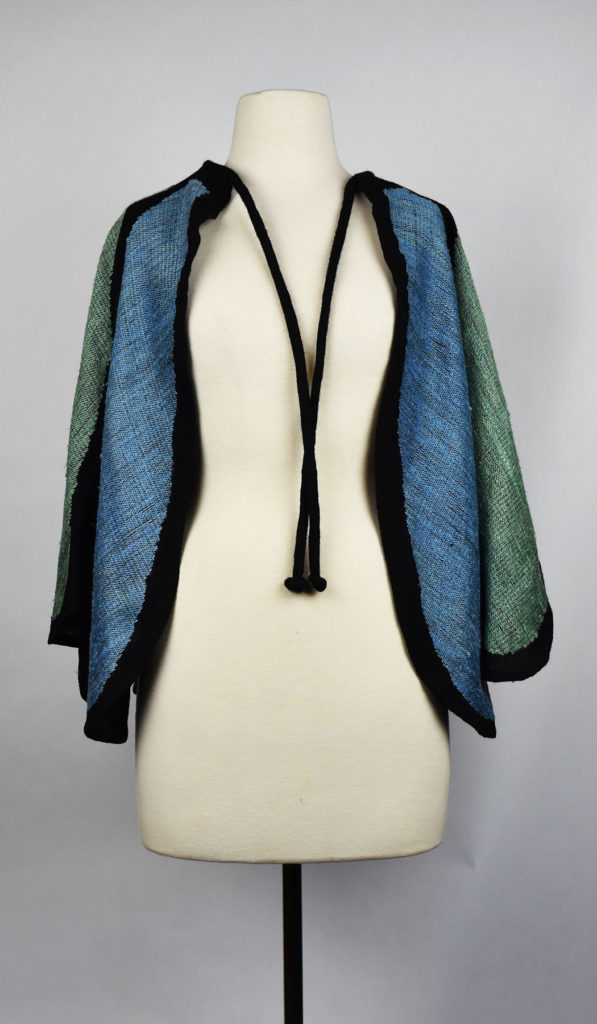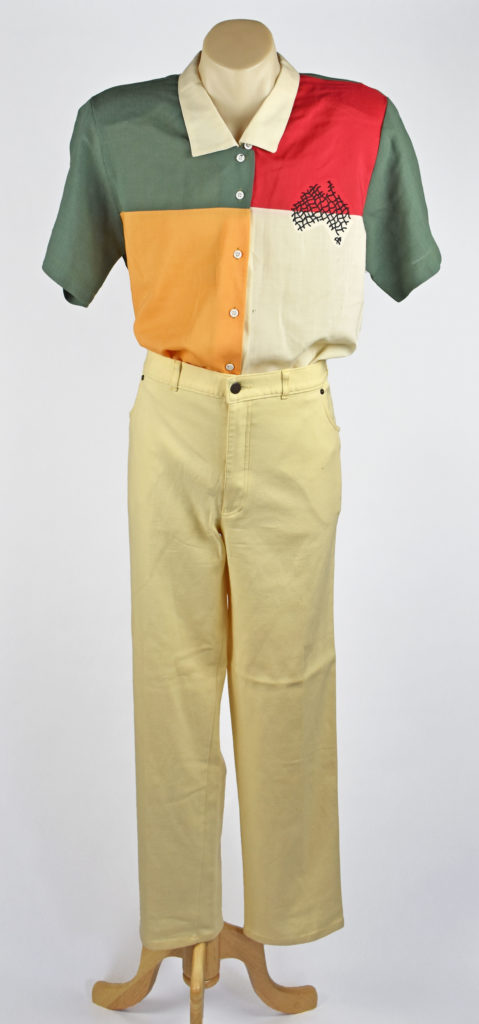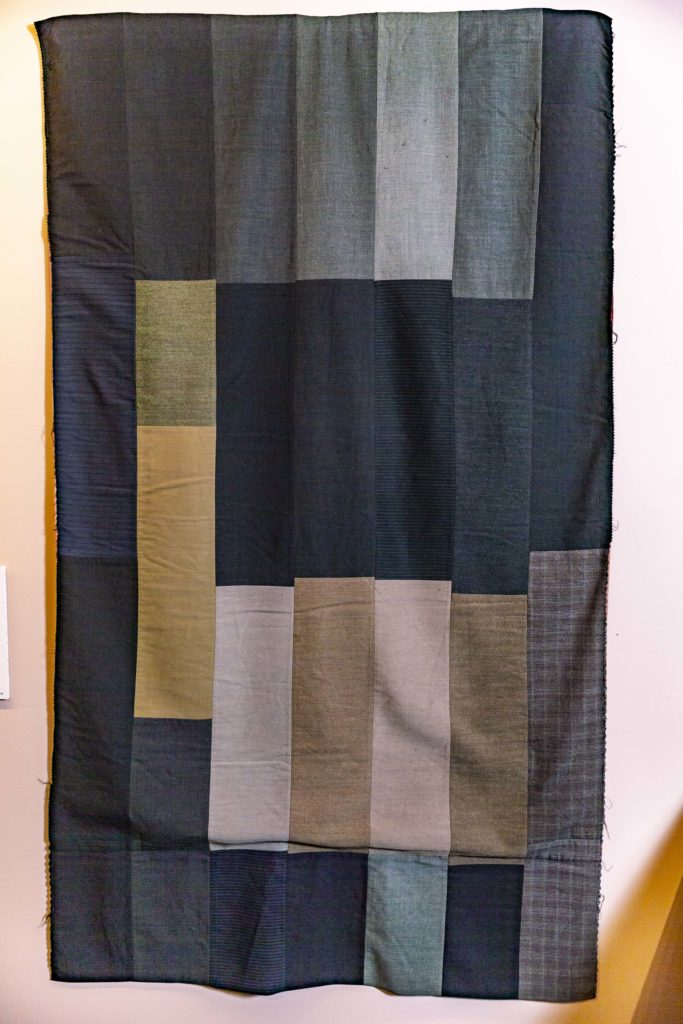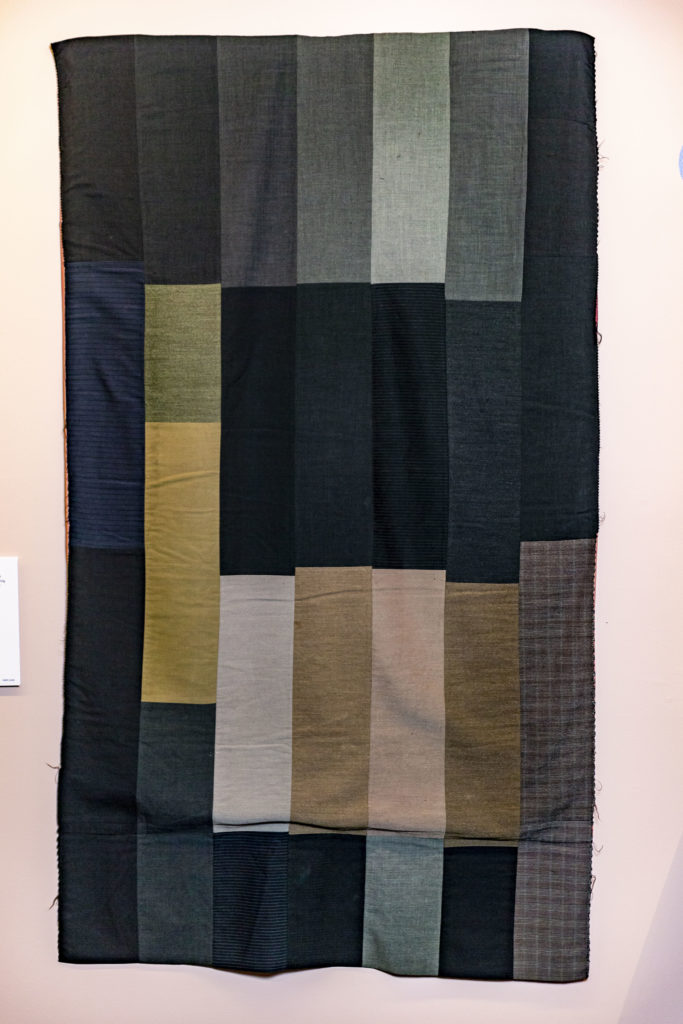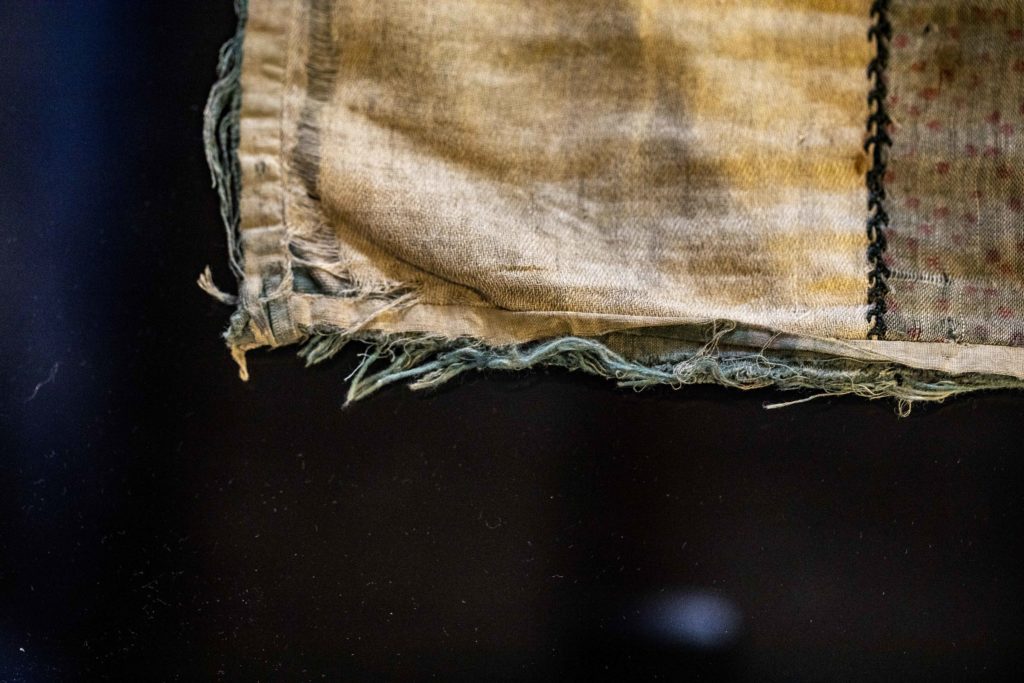Patons and Baldwins' Specialty Knitting Books
Patons and Balwins’ and many other yarn companies published kitting pattern books during the World War I and II containing instructions for articles of clothing carefully chosen to meet the requirements of the armed forces. Many of the articles of clothing were distributed by the Red Cross and Australian Comforts Fund.
Dress
This dress was made for the Melbourne Show in 1993 where it won 3rd prize. It was designed by Jean Inglis who was inspired by the Blue Triangle Butterfly (Scientific name: Graphium sarpedon choredon) for her design. The warp and weft for this dress was 2/24 commercially brought black wool. Jean utilised a new weaving technique devised by Theo Morgan in creating the dress. This method used a “tie down” thread of black polyester in the Warp in order to give it more texture. The dress was handwoven by Jean on her personal loom. Ruth Rondell assisted Jean with some of the pattern and final sewing.
Undervest
This wool undervest was purchased by Edith Bender for her husband Edwin. Edwin would catch a ‘Red Rattler’ train along the North Shore line to go to work in Pitt Street, Sydney. Edith was concerned Edwin would catch a cold in the unheated train or in his unheated office, so she brought these woollen undervests for him to wear to work. Edwin would wear the undervests under a woollen suit and with a woollen overcoat. Edwin passed away in 1963, at which point Edith stored the undervests away, unable to part with them.

Medallion
This medallion was struck to celebrate the 100th anniversary of fellmongering in Mazamet in 1951. Fellmongering – In French, ‘delainage” means, literally, ‘de-wooling’. It is the industrial process of separating wool from sheepskins. In the 19th century, the southern French town of Mazamet became the world centre of délainage and played an important part in the Australian wool industry. At one time Mazamet was reputed to be the 15th richest town in Europe, and it was said that the town’s branch of the Banque Nationale de Paris (French banking firm) was the second largest in France. At its height, Mazamet had 48 fellmongeries and imported more than 100,000 tonnes of sheepskins a year from the southern hemisphere, mostly from Australia and Argentina. The town continues to have a strong relation to Australia, with street names such as, Rue de Australie, Adelaide, Brisbane, Melbourne and Sydney.

THE WHITE FARM
The White Farm is a series of eleven artworks by Linda Gallus of a neglected sheep and cattle farm in Curlewis, Victoria. Purchased in 1994, the property was painted white for sale. The shearing shed has not been used since the sale and has turned to ruin over the last thirty years. Gallus was compelled to capture these buildings and their strange patina of white paint before nature reclaimed them completely. Two artworks from the series, Another Gust of Wind and Green Trough, are now part of the National Wool Museum Collection.
AWU Shearers Ticket
The 1891 Shearers’ Strike was one of the most significant events in the development of the Australian Labor Movement. Barcaldine in Central Queensland was the location for much of this conflict. Graziers were attempting to negotiate agreements on individual stations that went against union rules including a reduction in shearers’ wages. Queensland pastoralists engaged Victorian “free labourers” or “scabs” to keep their sheds running while local shearers were on strike. The conflict required armed police to guard Victorian shearers as riots toke place and woolsheds burnt down. With both sides bearing arms, there were thoughts of a possible “Australian Revolution”. The conflict ended in June 1891 with rebel shearers regaining work, however, several of the strike’s leaders were sentenced to prison

Geelong Football Club Jumper
This was the jumper of John Brown, who played 48 games for Geelong including the 1963 Grand Final in which he wore this jumper. Formed in 1859, the Geelong Football Club is the second oldest in the Australian Football League and one of the oldest clubs globally.

Ferrier Wool Press
Invented by Joseph Ferrier in 1866, the patent was purchased by Humble & Sons who manufactured and distributed them from their Geelong foundry. The Ferrier Wool Press was used throughout Australia, New Zealand and Africa. Sent out as a flatpack, the press was put together on the farm. This press was made by Humble & Nicholson in Geelong in 1890 and sold to Shanahan Brothers in Birregurra. A key feature of any woolshed, this wool press needed three people to tip over the wool filled top box before it was pressed into the lower box using the lever. It is an early example of Geelong’s long history of design, invention and manufacturing.
Olympic Uniform Collection
Wool holds a predominant role in our Olympic uniform history. Finest quality Australian wool has frequently been used to outfit our Olympic team. The 1992 Summer Olympics were held in Barcelona. Australia sent 279 competitors kitted out in uniforms designed by Wendy Powitt, who won the AWC’s Olympic Uniform Design Competition in 1990. Her designs highlighted the classic Australian colours of the bush with soft olive greens and creams and a bold floral design that reflected the styles of artists from the Australian Arts and Crafts Movement (1890-1914).
Squatter: The Great Australian Game
Squatter is a wool themed boardgame. With more than 500,000 games sold in Australia as of 2007, it is the most successful board game ever produced in Australia. The National Wool Museum holds the original “Squatter” board game design package as well as several versions of all major alterations to the game, such as the change to decimal currency and an electronic version of the game.

Fulling Machine
There is an extensive list of finishing processes in wool production for both worsted and woollen fabrics. Fulling is the immersion and pounding of fabric to make the fibres interlock. Crabbing permanently sets this interlock. Decanting shrink-proofs the fabric. Dyeing changes the fabrics colour. This large Fulling Machine is a distinctive item related to this phase of cloth production. Made by J. Dyson and Sons in Geelong, this Fulling Machine completes all the above steps, except dyeing, with a combination of hot water, soap and friction. Before the invention of such a machine, all these processes had to be completed individually.

CSIRO Prototype Self-Twist Spinner
Spinning fibres was one of the first processes to be mechanised in the Industrial Revolution. It took many hours of hand spinning to supply the thread needed for the most basic treadle loom. The Hargreave’s cotton-spinning jenny, Crompton’s spinning mule and Arkwright’s water frame in the 1770s are early examples of man moving from hand to machine. Spinning machines have undergone considerable technical evolution. The CSIRO was a leader in this field in the twentieth century. In 1962 it improved on the traditional Spinning Jenny and, in conjunction with the Australian company Repco, produced the Repco Self-twist Spinner. This machine was 15 times faster at spinning fibres. Ten self-twist spinners were installed at Macquarie Worsteds in Albury in 1971. The machines, operated in a small air-conditioned room by one operator, had an output of 1,200 conventional spindles worked by three operators. The prototype of this machine is held within the National Wool Museum’s Collection.
Noble Comb by Prince Smith & Sons
A nobel comb separates short fibres (known as noils) while also blending long fibres (known as tops) together. The long fibres are used for worsted materials while the short fibres are used for woollen fabrics. Woollen materials are soft, bulky and fuzzy, such as a picnic blanket; whereas worsted materials are fine, smooth and crisp, such as a suit jacket. The Valley Worsted Mills in Geelong, now the Little Creatures Brewery, ran twelve noble combs up until 1981.

Jacket
The wool for this jacket originates from two sheep many kilometres apart. The first fleece was shorn in Moree, NSW; the second in Beaufort, Victoria. The two fleeces were spun and woven by the donor’s mother, Marjorie Allnutt. The donor Philip Allnutt had a suit tailored out of this fabric at Ravensdale J & Son, 37 Swanson Street, Melbourne. They were members of the Master Tailors Federation of Victoria at the time.

Lizzie Morton’s Suit Fabric Wagga
This distinctive wagga was made by Mrs Lizzie Morton on her farm ‘Wanera’ at Benjeroop on the Murray River. It was stitched with a treadle machine. Her sister Flora MacDonald did the running stitch and provided the silk backing. The squares were sent as samples from a firm called ‘Fred Hesse’ who advertised in the Melbourne papers: “Be smart and dressy in a suit by Fred Hesse”. The buyer chose a sample and then sent it back with measurements and received a ‘mail order’ suit. In this case, the samples were used to make this unique quilt that has survived from the 1930s.
Tailor’s Wagga
The maker of this wagga is unknown. However, since the creator has used larger than usual pieces of suiting material, they may have worked as or knew of a tailor for their fabrics.
Child’s Cot Quilt
One of the earliest examples of a wagga quilt that exists in Australia. This quilt was made from reused patches and fabric scraps that were stitched together to create a warm covering for a child to sleep under. The quilt was made in Daylesford, but little is known about the maker or users of this quilt. As early as the depression of the 1890s, when times were difficult in Australia, making do became a way of life. The wagga quilt entered the list of uniquely Australian inventions that helped us survive through lean times.
Child’s Coverlet
This coverlet was made for Chris Neyland by Rene Densham when he was born in 1953. The quilt was created from scraps of woollen fabric from clothing used in the family. It was used in Chris’ cot or pram when he was an infant. His aunt Lois Densham donated the quilt. Lois can remember the dark green fabric coming from a jacket she once wore and the blue tartan pieces from a skirt worn by Rene, her mother. Lois also remembers her mother being “a better piano player than a cook or a sewer”. According to her, the quilt was “made in the tradition of making do from a family who knew how”.
Child’s Coverlet
This child’s coverlet was made from old blankets and clothing pieces with curtain and blanket backing. Maker unknown, from the Ballarat area.
By Wagga Design
The wagga quilt still lives on in quilting circles and the Australian imaginary. This contemporary take on the wagga is the winner of the Art Quilt Australia and National Wool Museum’s Expressions: Wool Quilt Prize (2019). Barbara Mellor, of St Helens in Tasmania, made this wagga after researching their history and was fascinated by this early form of recycling. Barbara sourced the used fabrics from a variety of places. Some are from her personal collection while others were given to her. She purchased a woollen three-piece suit from a local op shop and decided to incorporate it into the design, making some unique and distinctive shapes. Another notable feature of the quilt is the patch labelled ‘Parkside’. It was cut from a blanket she purchased from a garage sale from a property that had been the ‘Parkside’ caravan park in the 1960s. The filling of the wagga includes the rest of the Parkside blanket.
Patchwork Quilt
This turn-of-the-century English quilt is made from tiny hand-worked patchwork squares reminiscent of medallion style quilts. It is an extraordinary example of early quilts that arrived in Australia with immigrants. The maker is unknown. When it was found it was being used as packing material. The form and the aesthetic of this classic European quilt demonstrates the stark contrast with Australian wagga quilts. Through the difficult times of the 1890s and 1930s the wagga became a uniquely Australian form.
Red Cross Crazy Quilt
This is a classic crazy quilt. Although not technically a wagga, crazy quilts took many of the ‘make do’ techniques of wagga quilt making. This quilt was made in Highton, Geelong. It is a double bed sized quilt in the classic ‘crazy’ style with extensive use of herringbone and feather stitching. The pieced style of the quilt, made from squares of patchwork, is similar to the style of quilts made by members of the Country Women’s Association (CWA). The women sometimes made a quilt as a group activity and this one was possibly a 1930s group creation.
Lucy Anderson's Rug
These are samples of products made at the Returned Sailors and Soldiers Mill in Geelong but discontinued before 1960. They were used to show shops what materials were available. The samples were given to Mr Robert Anderson, an apprentice fitter and turner at the mill between 1960-1965. His mother, Mrs Lucy Anderson, sewed the samples into rugs in the early 1960s. Lucy’s rug shows that by 1960 the spirit of the wagga quilt and making do continued in the vernacular of Australian quilters.
Domestic Wagga
Little is known about the provenance of this wagga, but the vibrant colours, odd shapes and extraordinary composition conjure stories of its maker and its use.




